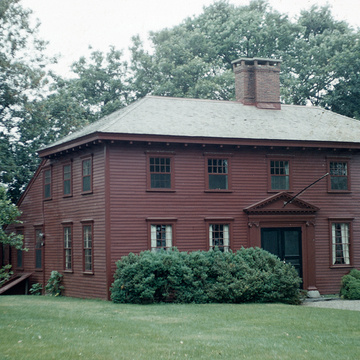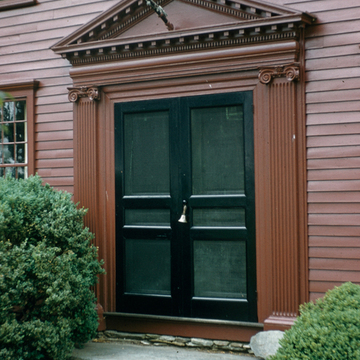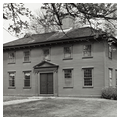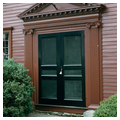You are here
Whitehall (Dean George Berkeley's Farm)
George Berkeley, then Dean of Derry in Ireland, later Bishop of Coyne, philosopher, poet, and philanthropist, traveled to North America in 1729 to establish a college in Bermuda. His ship was blown so far off its course that it landed in Newport. He liked Newport
Berkeley's adaptation aggrandized an existing farmhouse into a two-story, five-bay, central-chimney house with a lean-to behind. Although its overall character was vernacular, several characteristics gave it a lordly air: its roof, hipped instead of the commonplace gable; modillions at the eaves; and, most conspicuous, its broad, two-leaved door enframed by Ionic pilasters and pediment—more suitable as the entrance to a public building than to a farmhouse. When it became clear that funding for his college was unavailable, Berkeley returned to England, leaving his 96-acre farm and its library to Yale College. It was renamed Vaux Hall in 1769, served for a while as an inn, then gradually fell into disrepair. It was in this ruined state that Charles McKim discovered it in the 1870s. Then a young architect working in Newport, he was a newly converted enthusiast of the revival of colonial architecture and an editor of a short-lived architecture magazine, The New-York Sketch-Book of Architecture. He published a photograph of the building in its dilapidated state in the December 1874 issue of the Sketch-Book, a view from the rear which focused on the slide toward the ground of the warped lean-to roof as something almost more topological than architectural. It was the first photograph of any subject ever published in an American architectural journal. At this evidence of the deteriorated state of Whitehall's fortunes, the National Society of the Colonial Dames of America came to the rescue by restoring the house in 1899, under a 999-year lease of the property from Yale. It was restored again in 1936 by Norman Isham, and yet again in 1966–1968. After its deterioration and triple restoration, it is hardly surprising that much of the interior is conjectural.
As for Berkeley's vista, it remained until the mid-1980s, when Whitehall Farm, a cluster development, was built between Whitehall and Hanging Rock. If a multitude of clapboard gables and dormers of varied size and disposition can make a “village” of mass housing, this is the evidence.
Writing Credits
If SAH Archipedia has been useful to you, please consider supporting it.
SAH Archipedia tells the story of the United States through its buildings, landscapes, and cities. This freely available resource empowers the public with authoritative knowledge that deepens their understanding and appreciation of the built environment. But the Society of Architectural Historians, which created SAH Archipedia with University of Virginia Press, needs your support to maintain the high-caliber research, writing, photography, cartography, editing, design, and programming that make SAH Archipedia a trusted online resource available to all who value the history of place, heritage tourism, and learning.















